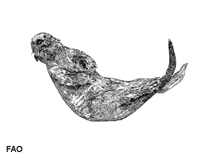Enhydra lutris (Linnaeus, 1758)
Sea otter| Native range | All suitable habitat | Point map | Year 2050 |

|
| This map was computer-generated and has not yet been reviewed. |
| Enhydra lutris AquaMaps Data sources: GBIF OBIS |
Classification / Names ชื่อสามัญ | ชื่อพ้อง | CoL | ITIS | WoRMS
Mammalia | Carnivora | Mustelidae
Environment: milieu / climate zone / ระดับความลึก / distribution range นิเวศวิทยา
สัตว์หน้าดินในเขตน้ำลึก; ระดับความลึก 0 - 25 m (อ้างอิง 78507). Subtropical
Distribution ประเทศต่างๆ | พื้นที่จำแนกตาม FAO | ระบบนิเวศหลายระบบ | การปรากฏขึ้น,การเกิดขึ้น,พบ | การแนะนำ
Pacific Ocean: Enhydra lutris lutris: Russia, Kamchatka, Kuril Island, Hokkaido; Enhydra lutris kenyoni: Aleutian and Pribilof Islands, east along the south shore of the Alaska Peninsula, northeast to Prince William Sound, and thence southeast to Washington State; Enhydra lutris nereis: from northern California south to Morro Hermoso in Baja California Norte, including the Farallon Islands, Channel Islands; Mexico (Ref. 1522).
Length at first maturity / ขนาด / Weight / Age
วัยเจริญพันธุ์: Lm ? range ? - ? cm Max length : 148 cm TL เพศผู้/กระเทย; (อ้างอิง 1394); 140 cm TL (female); น้ำหนักสูงสุดที่มีการรายงาน: 45.0 kg (อ้างอิง 1394); น้ำหนักสูงสุดที่มีการรายงาน: 45.0 kg
Life cycle and mating behavior วัยเจริญพันธุ์ | การสืบพันธุ์ | การวางไข่ | Eggs | ความดกของไข่ | Larvae
Main reference
อ้างอิง | ผู้ประสานงาน | ผู้ร่วมมือ
Jefferson, T.A., S. Leatherwood and M.A. Webber 1993 FAO species Identification Guide: Marine Mammals of the World. Rome, FAO. 320 p. + 587 figures. (อ้างอิง 1394)
IUCN Red List Status
(อ้างอิง 130435: Version 2025-1)
CITES status (อ้างอิง 108899)
CMS (อ้างอิง 116361)
Threat to humans
Human uses
การประมง: การค้า
FAO - การประมง: species profile | FishSource | ทะเลรอบๆเรา
เครื่องมือ
ข้อมูลเพิ่มเติม
Max. ages / sizes
Length-weight rel.
Length-length rel.
Length-frequencies
Mass conversion
อุดมสมบรูณ์
วัยเจริญพันธุ์
ความดกของไข่
การวางไข่
Eggs
Egg development
Larvae
แหล่งที่มาจากอินเตอร์เน็ต
BHL | BOLD Systems | CISTI | DiscoverLife | FAO(การประมง: species profile; publication : search) | Fishipedia | GenBank (genome, nucleotide) | GloBI | Gomexsi | Google Books | Google Scholar | Google | PubMed | แผนภูมิชีวิตแบบต้นไม้ | Wikipedia (Go, ค้นหา) | บันทึกทางด้านสัตววิทยา



